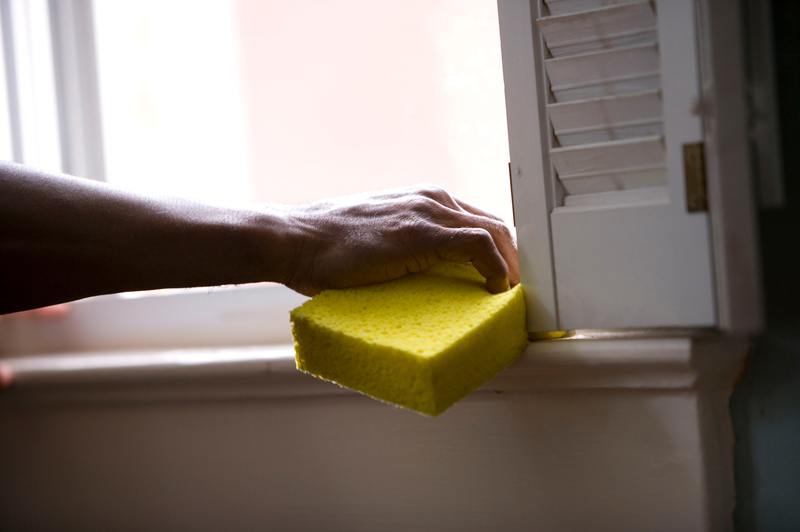Do you have any idea how to get mildew smell out of sponge? If you don’t, just read through this article, and we will give you all the tips you will need!
A kitchen sponge is often wet, making it a breeding ground for bacteria, and is most likely one of the germs’ favorite habitats in your home. To maintain good hygiene and remove odors, it is best to follow the tips explained below.

Why Do Sponges Stink?
Stinky sponges are not an uncommon problem to homeowners. There is no better way to deal with them than to know why they smell bad.
Sponges meet with dirty dishes on a daily basis. Dirt and food particles get trapped in between the fibers of the sponges and decompose quickly under the wet environment.
Germs, yeast, bacteria, and mold build-up during the decomposition process and cause a musty mildew smell. For more detailed information, read this article about what causes mildew smell.
Tips To Get Rid Of Mildew Smell On Sponge
Even if you wash the kitchen sponge with dish soap and water, it still has the tendency to smell bad after some time. It is why it is essential to deep clean it at least once a week using any of the following methods:
1. Cleaning with white vinegar
White vinegar is not just a simple condiment; it can do wonders in deodorizing kitchen sponges. It is very simple to use and will only take a few minutes of soaking.
Simply pour pure white vinegar directly over the sponge until it’s completely saturated. Allow it to sit for no less than five minutes before rinsing it with hot water.
2. Using a baking soda sponge deodorizer
Baking soda can match the cleaning powers of harsh chemicals. It effectively cleans dirt and deodorizes different pieces of stuff at home.
To use this mighty cleaning agent, all you have to do is mix warm water with four tablespoons of baking soda and soak the sponge in it. Leave it for a few hours to let the sponge absorb the solution.
Afterward, rinse the sponge with warm running water and squeeze all the water out. Air-dry it overnight before you reuse the sponge.
3. Disinfecting using bleach
No matter how clean a kitchen sponge looks all the time, it can never stay clean as bacteria quickly grow in it. The easiest solution to this is to disinfect using a bleach solution.
The process will only take a few minutes, and you will have the fresh-smelling sponge again. The first thing you need to do is mix warm water and ½ to one teaspoon of bleach in a container.
Then, wring out the sponge and place it in the bowl with the solution. It is better if you wear gloves to protect your hands as bleach can cause skin irritation.
Soak the sponge for at least 20 minutes before rinsing it with clean water, let it dry thoroughly, and you’ll have a fresh-smelling sponge once again.
4. Sanitizing through the microwave
Putting your kitchen sponge in a microwave is an effective way of sanitizing and can kill 99% of germs, yeast, food-borne bacteria, and mildew. You can clean your sponge using the microwave by following a simple procedure.
Thoroughly wet the sponge, then put it inside the microwave. Set it on high power and run it for at least two minutes.
Cool it thoroughly before you use it again.
5. Run the sponge in the dishwasher
The dishwasher cannot only clean the dishes but can also do the same to your dish sponge. Just lay it flat on the rack and let it go through a whole wash, dry, and rinse cycle.
You can use the same dishwashing soap you use when washing the dishes. It will wash out the embedded grease and food and get rid of the odor on the sponge.
6. Letting the sun do the magic
The final tip is a natural deodorizing method which is so simple yet effective. The sun is known to have disinfecting properties for clothes, and it does the same for kitchen sponges.
When dried under the sun, the sponges will not smell like mildew anymore and will be completely sanitized. Just place it on a plate and position it in an area with direct sunlight.
If not only your sponge smells like mildew but also the water that you drink, here is a guide on “why does my water smell like mildew” that you can check out.
Conclusion
It is essential to keep your kitchen sponges clean at all times as it comes into contact with the utensils you use for eating. Due to constant exposure, it is very prone to mildew growth which we have to avoid if we want to be safe.
We have shared various ways on how to get mildew smell out of sponge, so we are hoping you can apply them. It can be even more effective if you mix up cleaning routines for an odor-free and fresh-smelling kitchen sponge.
